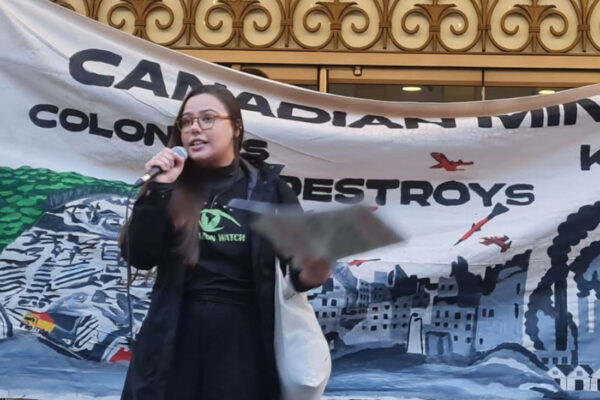Two key Peruvian state institutions are blocking plans to establish a reserve for indigenous people living in “voluntary isolation” (IPVI) between the Napo and Tigre rivers in the Amazon rainforest.
Opposition to the proposal was condemned by national indigenous organisation AIDESEP after a meeting, held in December, of a cross-sector government commission set up to create such reserves.
In June last year Peru’s vice-ministry of inter-culturality (VMI), the state entity responsible for indigenous peoples, officially recognised the existence of IPVI in the Napo-Tigre region and supported the proposal to create the reserve. According to the VMI’s memo 190-2013:
This communiqué gives favourable qualification for the recognition of indigenous peoples in isolation, probably related to the Arabela, Iquito, Taushiro, Zápara, Waorani and Abirija peoples, and the categorisation of the Curaray, Napo, Arabela, Nashiño, Pucacuro, Tigre and Tributaries’ Indigenous Reserve, details of which are in the attached documentation.
Memo 190 was sent by the then vice-minister of inter-culturality, Paulo Vilca Arpasi, to the then president of the cross-sector commission, Hernán Coronado Chuecas, together with 357 pages of reports, maps, letters and sworn testimonies principally supporting the IPVI’s existence.
However, the proposed reserve is almost entirely overlapped by oil concessions including, most significantly, lot 39, run by Repsol, and lot 67, run by London- and Paris-based Perenco together with Vietnamese state oil and gas company PetroVietnam.
Several months after memo 190 was emitted, Perupetro, the state agency promoting oil and gas operations, wrote to the VMI “appealing” it and requesting that the culture ministry, in which the VMI is situated, “annul” it.
The ministry responded by conducting an internal legal analysis, which concluded that memo 190 couldn’t be annulled on legal grounds but recommended instead that the VMI “rescind” it because it was not “scientifically rigorous” enough and didn’t include “reliable” proof of the IPVI.
This legal analysis was sent to Perupetro on 20 November, and five days later, following the resignation of both Vilca Arpasi and Coronado Chuecas over a controversy about IPVI elsewhere in Peru, the new vice-minister, Patricia Balbuena Palacios, rescinded memo 190.
Perupetro’s strategy to block the reserve has also included urging Perenco to take “legal actions”, according to a letter written on 21 October by Perenco’s Benoit de la Fourchardiere and sent to Perupetro’s Milton Rodriguez Cornejo:
This is a reply to the letter sent to us on 3 October in which you demonstrate that you share our concern about the favourable qualification given by the vice-ministry of inter-culturality and that as a result you will take legal actions, suggesting to us that as an affected party we take similar legal actions.
De la Fourchardiere went on to say that Perenco had had a meeting with Perupetro the week before, and thanked it for its “swift attention” on “such a relevant issue” and asked to be kept informed about developments. Regarding Perupetro’s suggestion to take “legal actions”, de la Fourchardiere wrote that the “legitimate solution” would be for the culture ministry to annul the memo.
For the proposed reserve’s supporters, the VMI’s sudden U-turn is particularly bitter because it had been due to be discussed by the cross-sector commission in October, but was postponed until its next meeting in December because there weren’t enough people present.
According to AIDESEP, Balbuena Palacios told the commission in October that the proposal would be discussed in December, but by the time that meeting took place she had rescinded memo 190 and put plans to establish the reserve back to what AIDESEP calls “stage zero.”
Balbuena Palacios told the Guardian that the Napo-Tigre proposal would have been discussed in October if only one more person had been present, and confirmed that she had said it would be discussed in December instead.
AIDESEP is now appealing the VMI’s decision to rescind memo 190 and has held a meeting with Peru’s state ombudsman, the Defensoría del Pueblo, to urge it to intervene. After the cross-sector commission meeting on 5 December, AIDESEP issued a condemnatory statement which said:
The Napo-Tigre proposal is put back to stage zero after Perupetro presented a request to annul it to the vice-ministry arguing that the proof [of IPVI] provided was not sufficient and the way in which it was presented was not adequate. Following this explanation from the president of the Commission … Henderson, one of AIDESEP’s national leaders, expressed his dissatisfaction and discontent, pointing out that AIDESEP and ORPIO [a regional organisation affiliated to AIDESEP] have presented evidence showing the existence of isolated peoples in the region.
Bizarrely, despite the VMI’s U-turn, a record of the meeting signed by participants accepts there are IPVI in the Napo-Tigre region: “Taking into account the Defensoria’s proposal about protecting the population in isolation in the proposed Napo-Tigre reserve, the DGPI [Peru’s head office for indigenous peoples’ rights, situated within the VMI] will perform the necessary, cross-sector coordination to protect them.”
This record also states that the DGPI agreed to perform “further studies required to support the Napo-Tigre reserve proposal” within the next three months.
Balbuena Palacios told the Guardian that the decision to rescind memo 190 was aimed at correcting irregularities in the Napo-Tigre proposal, updating the information, and allowing time to do fieldwork between February and April – with the ultimate aim of presenting the results to the cross-sector commission in May or June.
Meanwhile, Perenco has continued to operate in lot 67 in what is the heart of the proposed reserve. On 5 December, the very same day as the cross-sector commission meeting, Peru’s president Ollanta Humala visited the concession to mark the start of oil production.
A Peruvian law passed in 2006 states that reserves for the IPVI should be “intangible”, but a loophole, which appears to contradict international law, allows natural resource exploitation if considered in the “public necessity” – as operations in lot 67 were deemed in 2009.
To date, both AIDESEP and ORPIO have collected considerable evidence of the IPVI in the Napo-Tigre region and written various reports detailing it, and a very wide range of institutions and individuals including government ministries, NGOs, and companies have acknowledged their existence.
These even appear to include the Norwegian ministry of finance’s council on ethics which has recommended the ministry divest from Repsol because of the threats that its operations in lot 39 pose to the IPVI, according to NGO Rainforest Foundation Norway and Norwegian TV channel TV2.
The reserve in the Napo-Tigre region was first proposed in 2003. Another four reserves for IPVI have been proposed, one of which received the vice-ministry’s support in October and the other three in December – described by Balbuena Palacios as an “important advance.”
Perenco declined to comment and Perupetro could not be reached.













